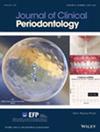有或没有角化组织和不同粘膜厚度种植体愈合部位早期口腔骨吸收:一项实验动物研究
IF 5.8
1区 医学
Q1 DENTISTRY, ORAL SURGERY & MEDICINE
引用次数: 0
摘要
目的评价有无口腔角化组织(KT)的早期口腔骨吸收(BBR),以及在愈合部位放置不同粘膜厚度(MT)的情况。材料与方法9只beagle犬,在半上颌第3和第4前磨牙拔除3个月后,将全厚度皮瓣抬高并植入2个组织水平的种植体。缝合前,将每只狗随机分为3组(对照组、非角化组织、NKT和非角化组织+结缔组织移植物,NKT - CTG)。在两个实验组(NKT和NKT‐CTG)中,均切除颊部KT。在NKT - CTG组中,CTG与颊牙槽黏膜瓣(BF)缝合,并在种植体颈部周围冠状复位,而在NKT组中,仅BF复位。对照组将带2 mm KT带的BF重新定位在种植体周围。临床基线测量颊骨厚度(BBT)、MT和KT宽度。3个月后对BBR和MT进行组织学分析。结果NKT组与对照组手术时粘膜厚度相近(分别为1.33±0.26 mm和1.67±0.52 mm)。在NKT - CTG组中,MT为2.50±0.45。三组在中颊区测量的平均BBT约为1 mm。3个月后,各组均出现早期BBR,平均为0.91 mm±0.62(对照组)、1.11 mm±0.69 (NKT)和1.10 mm±0.58 (NKT‐CTG)。距边缘黏膜1.5 mm处MT的平均值分别为1.20 mm±0.69(对照组)、2.18 mm±0.53 (NKT)和3.45 mm±1.33 (NKT‐CTG)。结论在本研究的范围内,KT的存在或不存在对早期BBR没有影响。CTG放置在没有KT的区域并没有阻止早期BBR。本文章由计算机程序翻译,如有差异,请以英文原文为准。
Early Buccal Bone Resorption in Areas With or Without Keratinized Tissue and Different Mucosal Thickness at Implants in Healed Sites: An Experimental Animal Study
AimTo evaluate early buccal bone resorption (BBR) in areas with or without buccal keratinized tissue (KT), and different mucosal thickness (MT) following implant placement at healed sites.Materials and MethodsIn 9 beagle dogs, three months following the hemimaxilla third and fourth premolars extraction, full‐thickness flaps were elevated and two tissue‐level implants were inserted. Before suturing, each dog was randomly assigned into 3 groups (control, non‐keratinized tissue, NKT and non‐keratinized tissue plus connective tissue graft, NKT‐CTG). In both experimental groups (NKT and NKT‐CTG), buccal KT was excised. In the NKT‐CTG group, a CTG was sutured to the buccal alveolar mucosa flap (BF) and coronally repositioned around the implant neck, while in the NKT group, only the BF was repositioned. BF with a 2 mm KT band was repositioned around the implants in the control group. Buccal bone thickness (BBT), MT and KT width were measured clinically at baseline. Three months later, BBR and MT were analysed histologically.ResultsMucosal thickness at surgery was similar in NKT and control groups (1.33 ± 0.26 mm and 1.67 ± 0.52 mm, respectively). In the NKT‐CTG group, MT was 2.50 ± 0.45. The mean BBT measured at the mid‐buccal region was about 1 mm in the 3 groups. Three months later, early BBR was observed in all groups, with mean values of 0.91 mm ± 0.62 (control), 1.11 mm ± 0.69 (NKT) and 1.10 mm ± 0.58 (NKT‐CTG). The mean values of MT at a 1.5 mm distance from the marginal mucosa were 1.20 mm ± 0.69 (control), 2.18 mm ± 0.53 (NKT) and 3.45 mm ± 1.33 (NKT‐CTG).ConclusionsWithin the limitations of the present investigation, the presence or absence of KT did not affect early BBR. CTG placed in the zones without KT did not prevent early BBR.
求助全文
通过发布文献求助,成功后即可免费获取论文全文。
去求助
来源期刊

Journal of Clinical Periodontology
医学-牙科与口腔外科
CiteScore
13.30
自引率
10.40%
发文量
175
审稿时长
3-8 weeks
期刊介绍:
Journal of Clinical Periodontology was founded by the British, Dutch, French, German, Scandinavian, and Swiss Societies of Periodontology.
The aim of the Journal of Clinical Periodontology is to provide the platform for exchange of scientific and clinical progress in the field of Periodontology and allied disciplines, and to do so at the highest possible level. The Journal also aims to facilitate the application of new scientific knowledge to the daily practice of the concerned disciplines and addresses both practicing clinicians and academics. The Journal is the official publication of the European Federation of Periodontology but wishes to retain its international scope.
The Journal publishes original contributions of high scientific merit in the fields of periodontology and implant dentistry. Its scope encompasses the physiology and pathology of the periodontium, the tissue integration of dental implants, the biology and the modulation of periodontal and alveolar bone healing and regeneration, diagnosis, epidemiology, prevention and therapy of periodontal disease, the clinical aspects of tooth replacement with dental implants, and the comprehensive rehabilitation of the periodontal patient. Review articles by experts on new developments in basic and applied periodontal science and associated dental disciplines, advances in periodontal or implant techniques and procedures, and case reports which illustrate important new information are also welcome.
 求助内容:
求助内容: 应助结果提醒方式:
应助结果提醒方式:


